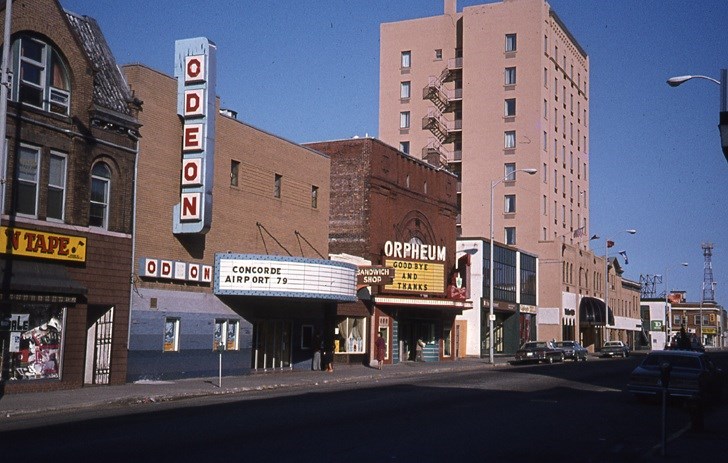Early residents of Sault Ste. Marie had a lot of choices when it came to live theatre. Did you know that between 1901 and 1923, the Sault had over 15 theatres? Of course the popularity of vaudeville, performances which could include magicians, dancers, trained animals, hypnotists and acrobats, were very popular in the United States and Canada from the early 1880s until the early 1930s.
Bowlby’s Hall, located on the second floor of a building on the southwest corner of Queen and Bruce Streets, later the site of the Algoma Hotel, was directly across the street from the International Hotel. It has been suggested that it was built around 1889, at the same the time as the International Hotel. With wide stairs leading up to the second floor from Queen Street and ordinary kitchen chairs used for seating it featured a stage about 25 feet wide and approximately 15 feet deep. The curtain displayed painted advertising for local businesses such as Bassingthwaite’s Furniture, Plummer’s Store, Blain Druggist, Durham’s Bakery, Vaughn Tailor, Beck’s Hardware and Butterfield’s Jewellery, to name just a few. Bowlby’s also featured travelling shows like Tom Marks Group whose repertoire included The Day the Farmer Came to see the Town, Uncle Tom’s Cabin, East Lynne and The Face on the Bar-Room Floor.
The City Directory from 1901 shows the Canadian Theatre on the corner of Brock and Bay Streets listing William Cranston as the manager. Another one of the early theatres in the Sault was the Grand Opera House, built in 1903 by Albert Search located in the same area, at Bay and Brock Streets. It closed in 1923 and later became home to Bayle’s Tire Service before being demolished in 1972.
With the development of moving pictures, other theatres began to open. The Orpheum Theatre at 631 Queen St. E. featured its own orchestra to accompany silent films and other entertainment, including the vaudeville shows. It opened on Apr. 15, 1912, the same day that the Titanic sank! The Orpheum played host at one time to Wallace Rei and Anita King in The Golden Fetter. It was demolished in 1979 when the owners, Famous Players, felt that the repairs to a damaged ceiling would be too costly.
In October of 1912, Mr. George Woolrich began work on the Steelton Theatre on the south side of Wellington Street, just east of the C.P.R. tracks. The cost for this new theatre was $20,000 and had a capacity of 750 seats. The general design was to be the same as the Orpheum Theatre but it was to be used for vaudeville. Under the management of Mr. Walker and Mr. Barrett who also managed the Orpheum, the tagline was The Big Show for the Little Money and featured shows like The Girl from Luxemburg, The Pink Widow, and Oh, Oh, Pauline.
Other theatres included the Bijou and Lyceum Theatres, located on Brock Street at Queen Street, and the Gayety Theatre, located in the Adams Block at 561 Queen St. E. The Duchess Theatre, a motion picture theatre opened in 1916 and was praised for its beautiful interior and five-piece orchestra. In later years, it became the site of the Savoury Restaurant on Queen Street.
King’s Theatre, now the King Apartments at Queen and Dennis Streets opened with a capacity for 1,200 people, making it the biggest theatre in town. The grand opening in 1913 featured seven reels of high class photo plays interspersed with music and singing. Prices were 10 and 15 cents, with special reserved seats and party stalls for 25 cents. The building was designed by architects, Mr. Drew and Mr. Gourlay and was modelled to resemble English theatres. The large stage measured 27 feet deep and 25 feet wide. The building and its contents cost between $75,000 and $80,000. The manager of the theatre was Mr. J. Backus. Featured entertainers included Emmy Wehlen in The Pretenders, a five-act Metro Wonderplay. In 1919 the King’s Theatre became Griffin Pictures owned by John and Peter Griffin.
The Princess Theatre opened at 163 Gore St. in 1917 as a high class silent movie (photo-play) house. Originally planned to be a 40 seat theatre until 1931 when renovations increased the seating capacity to 500. When originally built it cost between $12,000 and $15,000 and was only 115 feet long by 36 feet wide. The directors of the theatre were T.T. Barnes, Harold Megginson, M.C. McCuaig and Alex G. Fulton, with J.G. Gibson acting as manager and Mr. J. Huston as secretary-treasurer.
The Biltmore Theatre opened in 1948 at 641 Queen St. E. In 1965 it became known as the Odeon Biltmore Theatre then changed to just the Odeon Theatre by 1968. In 2007, it continued under the name Grand Theatre.
The Algoma Theatre opened in 1920 at 654 Queen St. E., with matinees that cost 25 cents and evening showings for 35 cents. In 1920, the Algoma presented Thomas Meighan in Civilian Clothes and Sennett comedy A Fresh Start. With only the original façade still standing, it now operates as Smokey’s next door to Top Hat Billiards.
Though many of these theatres have come and gone, residents still have many opportunities to enjoy live theatre today!
